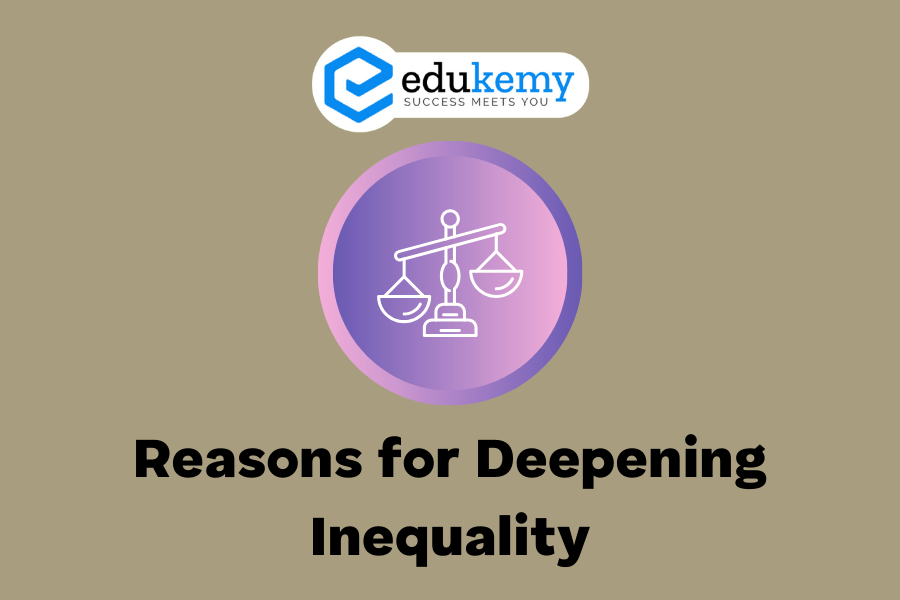
In recent years, the global landscape has witnessed a disconcerting trend: a deepening chasm of inequality that stretches across socioeconomic, racial, and geographical lines. While societies strive for progress and prosperity, the reality remains stark for many, with disparities widening rather than narrowing. This phenomenon is not isolated but rather the culmination of various interconnected factors that have compounded over time. From economic policies favoring the affluent to systemic biases perpetuating unequal opportunities, the reasons for deepening inequality are multifaceted and complex. Understanding these underlying drivers is imperative for devising effective strategies to address this pressing issue and pave the way towards a more equitable future.
The escalation of economic disparities in recent years can be attributed to several key factors:
- Cumulative Inequality:
- Inequality has accumulated over the years, forming a persistent and widening gap.
- Globalization and Corporate Opportunities:
- Greater opportunities for corporations in the era of globalization contribute to the widening economic divide.
- Capital Intensity of Growth:
- In labor-surplus countries, the capital-intensive nature of economic growth exacerbates inequality.
- Neglect of Agriculture:
- Neglect of the agriculture sector, upon which 60 percent of the population depends for their livelihood, is a significant factor.
- Financialization of Economy:
- The financialization of the economy provides the affluent with greater opportunities to accumulate wealth.
- Low Investment in Education and Health:
- Relatively low investment in education and health perpetuates the economic disparity, keeping the low-income group and poor in their disadvantaged state.
- Neglect of Skills Development:
- Insufficient attention to skills development further contributes to the widening gap.
- Urban-Rural Investment Discrepancy:
- Discrepancy in investment between urban and rural areas, favoring better-educated and wealthier urban populations, exacerbates inequality.
- Uneven Income Growth:
- Uneven growth in incomes across urban and rural areas, leading and lagging regions, and highly educated households versus less educated ones are important factors associated with increasing inequality.
The government aims to address these inequalities through the implementation of policies that focus on:
- Education, Health, and Skills Development Programs:
- Ensuring access to quality education, healthcare, and skills training.
- Rural Infrastructure Development:
- Prioritizing infrastructure development, particularly in rural areas.
- Labour-Intensive Growth:
- Promoting growth that generates employment opportunities.
- Backward Region Development:
- Initiatives aimed at developing backward regions and reducing regional disparities.
- Social Security Measures:
- Implementing social security measures to protect vulnerable populations.
- Increased Public Investment in Agriculture:
- Directing more public investment towards the agriculture sector.
As millions of children suffer from the consequences of inequality, public policy faces significant challenges in providing essential services such as nutrition, health, and basic education. Addressing these challenges is crucial for creating a more equitable and inclusive society.
Contents
- 1 FAQs
- 1.1 1. What role does technological advancement play in deepening inequality?
- 1.2 2. How does globalization contribute to deepening inequality?
- 1.3 3. What role does education play in perpetuating inequality?
- 1.4 4. How does government policy contribute to widening inequality?
- 1.5 5. What societal factors contribute to the persistence of inequality?
- 2 In case you still have your doubts, contact us on 9811333901.
FAQs
1. What role does technological advancement play in deepening inequality?
Answer: Technological advancement, while driving economic growth, has also exacerbated inequality. Automation has replaced many low-skilled jobs, widening the gap between skilled and unskilled workers. Additionally, tech monopolies have concentrated wealth among a few, further widening inequality.
2. How does globalization contribute to deepening inequality?
Answer: Globalization has led to the outsourcing of jobs to countries with lower labor costs, reducing job opportunities and wages in developed nations. Moreover, multinational corporations exploit tax loopholes and cheap labor, exacerbating income inequality within and between countries.
3. What role does education play in perpetuating inequality?
Answer: Education is often considered a pathway to upward mobility, but access to quality education is unequal. Affluent families can afford better schooling and resources, perpetuating advantages across generations. Furthermore, rising tuition costs and student debt disproportionately burden lower-income individuals, limiting their opportunities.
4. How does government policy contribute to widening inequality?
Answer: Government policies, such as tax cuts for the wealthy and deregulation, often favor the rich and powerful. This exacerbates wealth concentration while reducing social safety nets for the most vulnerable. Additionally, inadequate investment in public services like healthcare and affordable housing disproportionately affects low-income communities.
5. What societal factors contribute to the persistence of inequality?
Answer: Discrimination based on race, gender, ethnicity, and other factors perpetuates inequality by limiting opportunities for marginalized groups. Inherited wealth and privilege reinforce existing disparities, creating a cycle that is difficult to break. Moreover, social attitudes and stereotypes can further marginalize disadvantaged groups, hindering their socio-economic progress.
In case you still have your doubts, contact us on 9811333901.
For UPSC Prelims Resources, Click here
For Daily Updates and Study Material:
Join our Telegram Channel – Edukemy for IAS
- 1. Learn through Videos – here
- 2. Be Exam Ready by Practicing Daily MCQs – here
- 3. Daily Newsletter – Get all your Current Affairs Covered – here
- 4. Mains Answer Writing Practice – here

